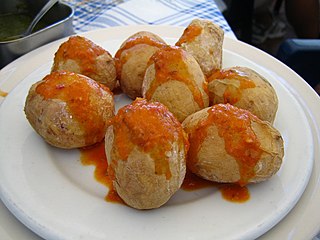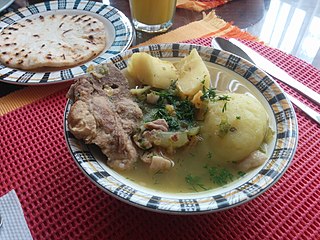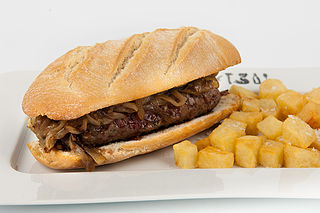
Guacamole is an avocado-based dip, spread, or salad first developed in Mexico. In addition to its use in modern Mexican cuisine, it has become part of international cuisine as a dip, condiment and salad ingredient.

Churrasco is the Portuguese and Spanish name for grilled beef prominent in the cuisines of Brazil, Colombia, Uruguay, and Argentina. The term is used in other Spanish- and Portuguese-speaking countries for a variety of different meat products.

Mojo is the name, or abbreviated name, of several types of sauces, varying in spiciness, consisting primarily of olive oil, local pepper varieties, garlic, paprika, cumin or coriander, and other spices. Mojo originated in the Canary Islands, where the main varieties are green mojo, red mojo, and spicy red mojo. Other countries have recipes similar to mojo, where acidic ingredients such as vinegar, lemon, orange, or lime juice may be used.

Chimichurri is an uncooked sauce used as an ingredient in cooking and as a table condiment for grilled meat. Found originally in Argentinian, Uruguayan, and Paraguayan cuisines, it has become widely-adopted in most of Latin America. The sauce comes in green and red varieties. It is made of finely chopped flat leaf parsley, red pepper flakes, minced garlic, olive oil, oregano and vinegar or lemon juice. It is similar to Moroccan chermoula.

Chicharrón is a dish generally consisting of fried pork belly or fried pork rinds. Chicharrón may also be made from chicken, mutton, or beef.

Sancocho is a traditional stew in Canarian cuisine and several Latin American cuisines. Latin variations represent popular national dishes in Dominican Republic, Colombia, Cuba, Honduras, Mexico, Ecuador, Panama, Puerto Rico, Trinidad and Tobago, and Venezuela. It usually consists of large pieces of meat, tubers and vegetables served in a broth.

Cypriot cuisine is the cuisine of the island of Cyprus, shared by both Greek Cypriots and Turkish Cypriots.The national dish is seftalia (greek:σεφταλιά)

Sopa de mondongo is a soup made from diced tripe slow-cooked with vegetables such as bell peppers, onions, carrots, cabbage, celery, tomatoes, cilantro, garlic or root vegetables. The dish is generally prepared in former Spanish colonies in Latin America, Caribbean, and in the Philippines.

Chili sauce and chili paste are condiments prepared with chili peppers.

Cuchifritos or cochifritos refers to various fried foods prepared principally of pork in Spanish and Puerto Rican cuisine. In Spain, cuchifritos are a typical dish from Segovia in Castile. The dish consists of pork meat fried in olive oil and garlic and served hot. In Puerto Rico they include a variety of dishes including morcilla, papas rellenas, and chicharron, and other parts of the pig prepared in different ways. Some cuchifritos dishes are prepared using plantain as a primary ingredient. Cuchifritos vendors also typically serve juices and drinks such as passionfruit, pineapple, and coconut juice, as well as ajonjolí, a drink made from sesame seeds.

Dominican cuisine is made up of Spanish, indigenous Taíno, Middle Eastern, African, Cuban, Puerto Rican and Haitian influences. The most recent influences in Dominican cuisine are from the British West Indies and China.

Tunisian cuisine, the cuisine of Tunisia, consists of the cooking traditions, ingredients, recipes and techniques developed in Tunisia since antiquity. It is mainly a blend of Mediterranean and native Punics-Berber cuisine. Historically, Tunisian cuisine witnessed influence and exchanges with many cultures and nations like Italians, Andalusians, French and Arabs.

Many cuisines feature eggplant salads and appetizers.

Sambal is an Indonesian chili sauce or paste, typically made from a mixture of a variety of chilli peppers with secondary ingredients such as shrimp paste, garlic, ginger, shallot, scallion, palm sugar, and lime juice. Sambal is an Indonesian loanword of Javanese origin. It originated from the culinary traditions of Indonesia and is also an integral part of the cuisines of Singapore, Malaysia, Brunei, and Sri Lanka. It has also spread through overseas Indonesian populations to the Netherlands and Suriname.

The pepito is a sandwich prepared with beef, pork, or chicken originating from Spain and also very popular in Latin America. It is a common street food in Venezuela and is also available at some U.S. restaurants. For the beef version, various cuts of beef are used, and myriad additional ingredients can also be used in its preparation.















